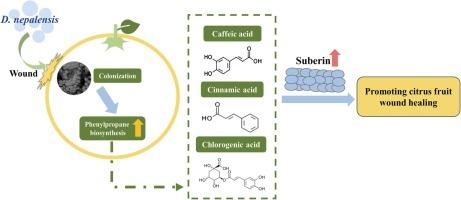尼泊尔德巴利酵母菌通过促进肉桂酸及其衍生物的合成,增强柑橘果实伤口中的单宁沉积
IF 6.4
1区 农林科学
Q1 AGRONOMY
引用次数: 0
摘要
柑橘类水果在采摘、运输、储存和销售过程中难免会受到机械损伤。以往的研究表明,柑橘类水果具有伤口愈合能力。果胶是伤口愈合的标志性物质。本研究探讨了尼泊尔德巴利酵母菌(Debaryomyces nepalensis)处理对促进柑橘类水果伤口愈合的影响及其机制。通过使用正交荧光显微镜检查经肾形德氏酵母菌处理的柑橘果实伤口处的单宁含量变化,以及经肾形德氏酵母菌处理的果实中绿色霉菌的发生情况,来评估肾形德氏酵母菌的效果。通过转录组和代谢组评估,分析了用尼泊金丝桃处理 3 天的伤口样本和同期自然愈合的伤口样本。结果显示,与自然愈合的伤口相比,经处理的伤口有明显的单宁积累。肾叶甘草明显改善了伤口愈合过程,降低了绿霉病的发病率和病变直径。此外,蛇床子素还激活了苯丙氨酸生物合成途径,导致 34 个基因上调,包括 COMT、HCT、CAD 和 PAL。因此,这种激活也导致了酚酸含量的显著增加,包括肉桂酸及其衍生物、咖啡酸和绿原酸。此外,这些酚酸的外源应用还进一步促进了伤口愈合,降低了绿色霉菌的发病率。总之,D. nepalensis 能激活苯丙烷生物合成途径,增强 COMT 等关键基因的表达,增加咖啡酸等物质的含量,从而促进柑橘类水果的伤口愈合。本文章由计算机程序翻译,如有差异,请以英文原文为准。

Debaryomyces nepalensis enhances suberin deposition in citrus fruit wound by facilitating the synthesis of cinnamic acid and its derivatives
Mechanical damage to citrus fruit is inevitable when picking, transporting, storing, and marketing. Previous studies have shown that citrus fruit have the ability to wound healing. Suberin is the signature substance for wound healing. This study investigates the effect of Debaryomyces nepalensis treatment on promoting citrus fruit wound healing and its mechanism. The effect of D. nepalensis was assessed through the examination of changes in suberin content at the wounds of citrus fruit treated with D. nepalensis using an ortho-fluorescent microscopy, as well as the occurrence of green mold in fruit treated with D. nepalensis. Wound samples treated with D. nepalensis for 3 d and those healed naturally over the same period were analyzed through transcriptome and metabolome evaluations. Results showed significant suberin accumulation in treated wounds compared to natural healing. D. nepalensis notably improved the healing process and reduced green mold disease incidence and lesion diameter. Additionally, D. nepalensis activated the phenylpropane biosynthesis pathway, which led to the upregulation of 34 genes, including COMT, HCT, CAD, and PAL. Consequently, this activation also resulted in a significant increase in the content of phenolic acids, including cinnamic acid and its derivatives, caffeic acid and chlorogenic acid. Moreover, the exogenous application of these phenolic acids further promoted wound healing and reduced green mold incidence. In conclusion, D. nepalensis activates the phenylpropane biosynthesis pathway, enhances the expression of crucial genes like COMT, and increases the content of substances such as caffeic acid to facilitate wound healing in citrus fruit.
求助全文
通过发布文献求助,成功后即可免费获取论文全文。
去求助
来源期刊

Postharvest Biology and Technology
农林科学-农艺学
CiteScore
12.00
自引率
11.40%
发文量
309
审稿时长
38 days
期刊介绍:
The journal is devoted exclusively to the publication of original papers, review articles and frontiers articles on biological and technological postharvest research. This includes the areas of postharvest storage, treatments and underpinning mechanisms, quality evaluation, packaging, handling and distribution of fresh horticultural crops including fruit, vegetables, flowers and nuts, but excluding grains, seeds and forages.
Papers reporting novel insights from fundamental and interdisciplinary research will be particularly encouraged. These disciplines include systems biology, bioinformatics, entomology, plant physiology, plant pathology, (bio)chemistry, engineering, modelling, and technologies for nondestructive testing.
Manuscripts on fresh food crops that will be further processed after postharvest storage, or on food processes beyond refrigeration, packaging and minimal processing will not be considered.
 求助内容:
求助内容: 应助结果提醒方式:
应助结果提醒方式:


